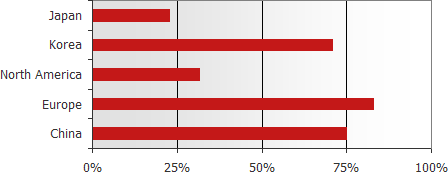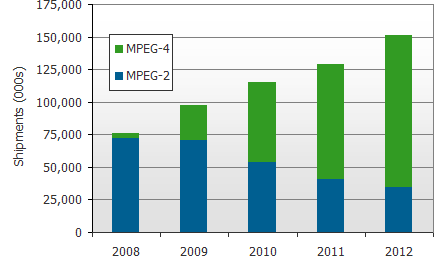TV Makers Looking to New Designs and Features to Break out of Commodity Trap
Wednesday, December 30th, 2009
Focus on 240 Hz, LED Backlights, 3D Capability, Connectivity, MPEG-4 Decoders, and Power Consumption
AUSTIN, TEXAS — Although this year’s average selling prices for TVs are expected to be down for the first time since the flat panel TV transition began, TV manufacturers are developing a wide variety of design elements and performance features to differentiate products and slow price declines. DisplaySearch, the worldwide leader in display market research and consulting, has initiated a new research service, the Quarterly TV Design and Features Report, to analyze and forecast these trends.
A key aspect of the development of these new features is the interplay of performance, features, cost and power consumption. Most features and performance improvements carry cost premiums and increased power consumption, but intelligent design and utilization of new technologies can enable simultaneous improvements. Key examples of this trend are LED backlights and 240 Hz frame rate operation in LCD TVs.
DisplaySearch’s research indicates that LED backlighting and 240 Hz LCDs will serve as an enabling technology for new feature developments in TVs in 2010, specifically for 3D TVs, an area of intense interest to TV manufacturers. DisplaySearch forecasts that 1.2 million 3D-capable TVs will be shipped in 2010, with growth to 15.6 million sets in 2013.
“The dilemma facing TV set manufacturers is whether to rush in with cheap solutions,” said Paul Gray, Director of TV Electronics Research. “If they skimp on processing and displays, performance will be disappointing and consumers will lose interest. While everyone is looking for a solution for the industry’s mediocre margins, technology alone cannot solve the economics, and it is important to take the time to develop the 3D proposition thoroughly.”
Power consumption is becoming an increasingly important issue in consumer electronics, with energy regulations becoming widespread in all regions–most recently in California. LED backlighting will continue to serve as a critical enabler of reduced power consumption. In the Q4’09 Quarterly TV Design and Features Report, energy regulations are examined with detailed descriptions of national regulations and ‘point of sale’ labeling policies.
DisplaySearch research indicates that there are significant performance differences by region. For example, in standby power consumption, Japanese TVs typically were under 0.3 Watts, European TVs were typically under 0.5 Watts. However, in North America, even the sets certified by Energy Star consume more power (typically 0.5-0.6 Watts). “In North America a substantial number of sets were found with standby power consumption levels over 1.0 Watts,” Gray added. “Other regions show that it is possible to reduce such waste, while saving the consumer money.”
The Q4’09 Quarterly TV Design and Features Report also examines connectivity and digital TV processing features. USB playback on TVs from cameras and memory devices is very popular in Europe, Korea and China, but has not been adopted in North America and Japan (as shown in Figure 1).
Figure 1: Penetration of USB Playback in 32-42″ TV Samples by Region

Source: DisplaySearch Quarterly TV Design and Features Report
In 2010, shipments of sets with MPEG-4 decoders will surpass those with MPEG-2, as connectivity features and second-generation digital broadcast become mainstream (as shown in Figure 2).
Figure 2: Shipments of Digital TVs by MPEG Decoder Type

Source: DisplaySearch Quarterly TV Design and Features Report
The DisplaySearch Quarterly TV Design and Features Report is a quarterly update of the issues and fast-moving feature development in TV sets. The 200+ page report examines and forecasts video processor and signal processing IC market development including 120/100 and 200/240 Hz frame rates and market shares for major IC vendors; feature forecasting for MPEG-4 decoding and the digital broadcast environment around the world; TV connectivity, such as wired and wireless networked TVs; LED backlighting; 3D capability; remote controls and chassis design; audio; and power consumption. In Q4’09 the report also analyzed the planned merger of NXP’s consumer activities with Trident Microsystems. The Quarterly TV Design and Features Report is the only report to combine all these aspects of a fast-moving market and examine how they interact, and is complete with a database of TV set featuring for over 200 models in low, mid and high positions in major regional markets.
The DisplaySearch 12th Annual USFPD Conference, called “Laying the Foundations for the Next Wave of Growth: Energy Efficient & Low Cost Alternatives Lead the Way” will be held March 2-3, 2010 at the Hilton San Diego Resort in San Diego, California. The event will focus on all major and emerging flat panel display applications, as well as key components and materials related to the supply chain. To view the agenda and register, visit www.displaysearch.com/usfpd. Register by January 25, 2010 to receive the early bird discount and save $400!
Latest News
- Tata Motors selects HARMAN Automotive's in-vehicle app store
- Media Distillery to power Swisscom ad-free replay product
- MagentaTV strengthens addressable TV business with Equativ
- Deutsche Telekom selects Broadpeak Cloud DVR solution for MagentaTV
- Nexxen empowers Australian advertisers using VIDAA ACR data
- TargetVideo integrates AI for video content categorization